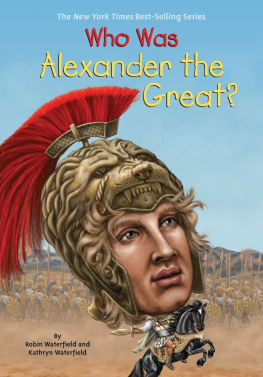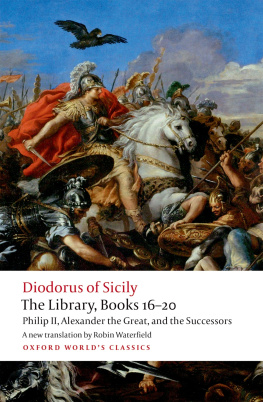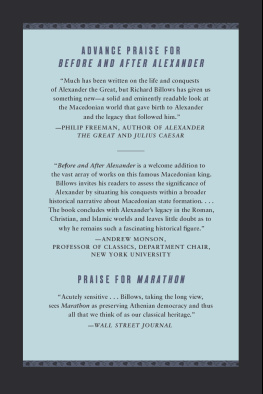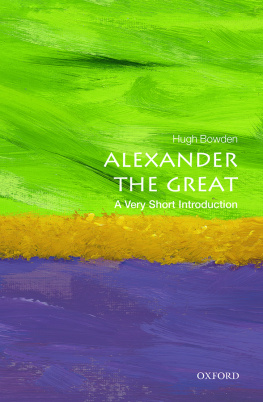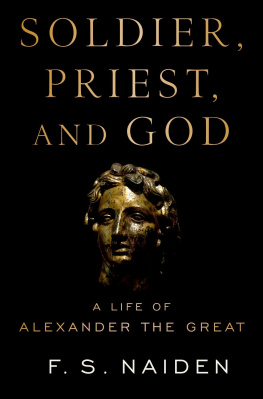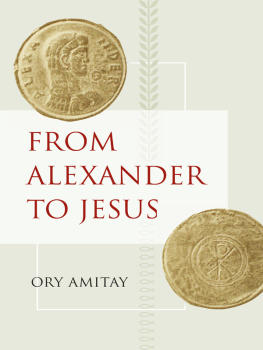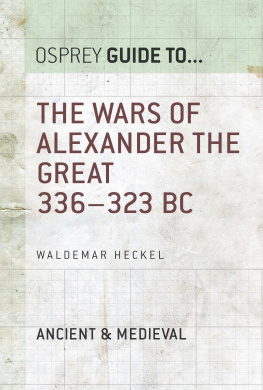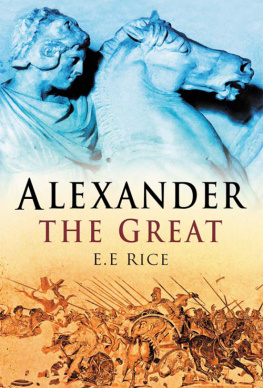IN SEARCH OF THE LOST TESTAMENT OF ALEXANDER THE GREAT
IN SEARCH OF THE LOST TESTAMENT OF ALEXANDER THE GREAT
DAVID GRANT

Copyright 2017 David Grant
The moral right of the author has been asserted.
Apart from any fair dealing for the purposes of research or private study, or criticism or review, as permitted under the Copyright, Designs and Patents Act 1988, this publication may only be reproduced, stored or transmitted, in any form or by any means, with the prior permission in writing of the publishers, or in the case of reprographic reproduction in accordance with the terms of licences issued by the Copyright Licensing Agency. Enquiries concerning reproduction outside those terms should be sent to the publishers.
Matador
9 Priory Business Park,
Wistow Road, Kibworth Beauchamp,
Leicestershire. LE8 0RX
Tel: 0116 279 2299
Email:
Web: www.troubador.co.uk/matador
Twitter: @matadorbooks
ISBN 978 1788031 622
British Library Cataloguing in Publication Data.
A catalogue record for this book is available from the British Library.

Matador is an imprint of Troubador Publishing Ltd
CONTENTS
Albert Olmstead, 1948
Half a century after the start of systematic, large-scale excavations, the huge labour by archaeologists, who have dragged from the earth ruins hidden in the past, and the patient work of all the scholars, who have concentrated the expertise on their finds, have revealed an inhabited land that had been terra incognita and given a face to the people, enigmatic until that point, whom Alexander led to the ends of the earth.
Miltiades Hatzopoulos, 1996
PRESS RELEASE
REMAINS OF PHILIP II,
FATHER OF ALEXANDER
THE GREAT, CONFIRMED FOUND
10 October, 2014, by April Holloway for Ancient Origins
Buried beneath a large mound located in the village of Vergina in northern Greece, an archaeological excavation carried out in 1977 by Greek archaeologist, Manolis Andronikos, uncovered a spectacular tomb holding the remains of ancient Macedonian royalty.
The historically important tomb has been the subject of intense debate ever since, dividing archaeologists over whose cremated remains were housed inside two golden caskets Philip II, father of Alexander the Great, and one of his wives; or Philip III Arrhidaeus, Alexanders half-brother, who assumed the throne after Alexanders death, with his wife Eurydice.Discovery News reports that, finally, the most detailed and extensive study ever conducted on the remains has settled the decades-old argument, confirming the bones indeed belong to the Macedonian King Philip II.
The Great Tumulus, as it came to be known, over 330 feet in diameter and 40 feet tall at the centre, was found to contain three primary burial sites. Tomb I, which was looted, contained fragmentary human remains believed to belong to three individuals.helmet, an elaborate ceremonial shield, an iron and gold cuirass, and two small ivory portrait heads believed to represent Philip II and Alexander. Tomb III contained a number of silver vessels and a silver funerary urn with the bones of an adolescent believed to be Alexander IV of Macedon, son of Alexander the Great.
Numerous studies have been published concerning the relatively intact human remains found in the twenty-four-carat gold casket in Tomb II. A study published in the journal Science in 2000, for example, concluded that the remains could not be Philip II as they did not bear traces of injuries that Philip supposedly suffered during his lifetime. Then, a study released in 2010 conversely stated that the remains must be Philip II as a notch in the eye socket is consistent with a battle wound received by Philip II at the siege of Methone in 355/354 BCE, years before he died.
To settle the score once and for all, an extensive anthropological investigation was launched to fully analyse more than 350 bones and fragments found in the two golden caskets. The research team, led by anthropologist Theodore Antikas, utilised X-ray-computed tomography, scanning electron microscopy, and X-ray fluorescence, to uncover any pathologies, activity markers, or trauma that could lead to the identification of the remains.
The results revealed features in the bones not previously seen or recorded. Antikas explained that the skull showed signs of sinusitis, which may have been caused by an old facial trauma, such as the arrow that is known to have hit and blinded Philip II at the siege of Methone. Furthermore, there are signs of chronic pathology on the surface of several rib fragments, which are believed to be linked to Philips trauma when he was struck with a lance around 345 BC. Finally, the bones reflect a fully-fleshed cremation, which disproves the theory that the remains belong to Philip III Arrhidaeus who had been buried for some time before being exhumed and cremated.
The analysis also revealed that the remains of the female in the antechamber are consistent with a female warrior and horse-rider, aged thirty to thirty-four. This find rules out the wife of Philip III Arrhidaeus, who was under twenty-five. Furthermore, a major fracture in her left tibia, causing leg shortening, explains the presence of a pair of Scythian greaves, in which the left side is shorter than the right. This indicates the Scythian weaponry and armour must have belonged to the female occupant of the tomb. Antikas told Discovery News that: No Macedonian king other than Philip II is known to have had relations with a Scythian.
AUTHORS NOTE
Discovery News also reported on further revelations that additionally shed light on Tomb I. During the study being undertaken by Antikas team, a young archeologist working on his thesis at Vergina found three wooden crates in a storage place filled with bone fragments and artefacts from Tomb I: three plastic bags containing well over one hundred bone fragments never before studied. Until then, Tomb I had been thought to hold solely a male, female and infant. But the seventy identified bones suggest the chamber held at least seven individuals: an adult male, a female, a child, four babies aged eight-ten lunar months and one foetus of six and a half lunar months. Antikas believes: This find disproves every previous hypothesis of historians and archaeologists alike that Tomb I was intended for Philip II and his last wife. Discovery News, October 10, 2014.

The two small ivory portrait heads found in Tomb II and believed to depict Philip II and Alexander.
Do not bury my bones apart from yours, Achilles But let them lie together, just as we were raised in your house So may the same vessel contain both our bones The golden amphora, which your lady mother gave you.
Homer Iliad
EXCAVATING HOMERIC HEROES: AUTHORS COMMENTARY
The ancient city of Aegae where the royal tombs are located dates back to the 7th century BCE; it became Macedonias first capital after it was conglomerated from a collection of villages into a city in the 5th century BCE. Aegae was eventually supplanted by a new capital at Pella in the 4th century BCE but retained its status as the spiritual home and burial ground of the Macedonian kings.
Both settlements were partially destroyed by Rome in 168 BCE following the Battle of Pydna when Macedonia was finally defeated, and a landslide buried the older capital in the 1st century, after which it was uninhabited. The name Aegae ceased to be used and its history was grazed over by goats and sheep and survived in oral legend only, while papyri and faded vellums told of a former city of kings. Only a nearby early Christian basilica built from the stones of the ancient ruins marked the forgotten location. In the 1920s, on what had once been the southeast side of the Macedonian royal palace, Greek refugees from the Euxine Pontus region of Asia Minor founded the village of Vergina, and the still unidentified fallen stones were used as masonry in the new houses.
Next page




